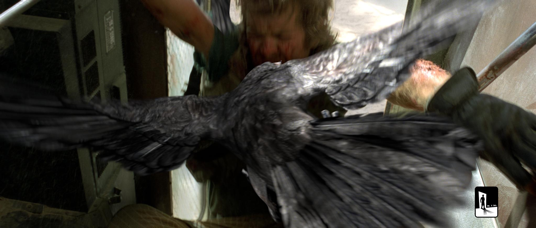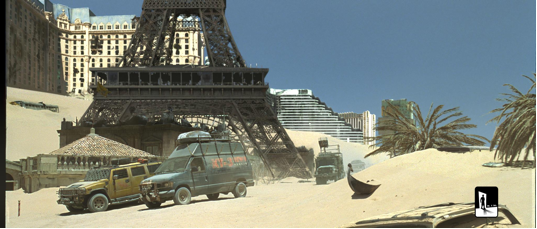 A Case Study from the Foundry
A Case Study from the Foundry
What follows the Apocalypse? Extinction, of course. Like its predecessors, the third installment of the Resident Evil trilogy is rife with zombies, survivalists, Milla Jovovitch, villains, and… zombies. But given that this was the final chapter (so says the official word), the filmmakers wanted to send fans of the video-game-inspired film series off with a lasting impression. To create it they looked to the VFX experts known for dealing handily with the undead on films like Silent Hill, Skinwalkers, Dead Silence and Dawn of the Dead  Mr. X.
For Resident Evil: Extinction, the Toronto, Ontario digital studio Mr. X (whose credits go far beyond horror films with Four Brothers, Hollywoodland, A History of Violence and many others) delivered spine-tingling imagery of Las Vegas under siege, various super-human and undead beings, and creep-tastic experiments. The lead VFX house on the film, Mr. X oversaw all of the film’s 500 VFX shots. Twenty-two compositors completed more than half of those in-house at Mr. X using the Nuke compositor.
The speed’s the thing
Nuke is a high-end compositing system from The Foundry with particular strengths in speed, 3D workspace, and multi-channel compositing/Open EXR. Aaron Barclay, head of compositing at Mr. X, brought the software in for a test run in 2006 to evaluate its 3D features for a film called Shoot ‘Em Up. “I had been looking at Nuke and saw it as a very powerful piece of software that was going somewhere others weren’t, in terms of speed and in the way compositors interact with it.â€Â
Nuke was brought in as a secondary toolâ€â€Shake and Combustion were the studio’s primary compositing packages. But on Shoot ‘Em Up, Barclay said, “Within three weeks everyone was up and running on Nuke and we were blown away by the speed and responsiveness. We used it so much that it just took over the whole show, and now it’s our primary compositor.â€Â

The studio runs Nuke on both Linux and Windows workstations, and Barclay runs it on OSX, on his laptop.
Powerful 3D integration streamlines the pipeline
After building their Nuke experience on Shoot ‘Em Up, the compositors were eager to push the software’s toolset in new directions. They got their chance on Resident Evil’s complex effects. One of the most memorable scenes, the vision of Las Vegas being destroyed, involved a number of shots where the camera was pulling back broadly over the city. With Nuke, lead compositor Philip Lange and his team were able to 3D-track the shot and use the camera within the 2D software to add buildings, debris, sky, smoke, and other elements using the same camera track.
“Before we had Nuke we would have had to send that shot back to the 3D team to track all of the individual elements and match textures and geometry,†said Barclay. “Doing this work inside Nuke gave us more control, and made the pipeline much more efficient. We could incorporate the client’s changes right away and turn requests around fast.†The technique of using Nuke projection mapping vs. sending shots to 3D was even coined “Nuke-style†compositing by the artists.
While they didn’t intend to at the outset, shot lead Dave Thompson and his team ended up creating complicated clone tank shots largely inside the Nuke compositor as well. In one shot a camera pulls back slowly through hundreds of transparent, fluid-filled tanks, each suspending hundreds of people. “It was hard to draw the line between 3D and 2D and decide whether a task should be done in Maya or to try and push Nuke’s 3D tools,†Barclay explained. “As the shot evolved we ended up doing it heavily in Nuke because that’s where the design process was happening. It was faster for the compositor to turn something around in Nuke than to send it to 3D. Really, it’s about turnaround and where the creative process is happening, and it’s great to have that flexibility driven by creativity, not by software limitations.â€Â
Creative consistency aided by multi-channel/Open EXR features
Another complicated sequence, showing the “Tyrant†character striking a victim, was achieved by Barclay and his team’s application of Nuke’s multi-channel Open EXR features. Nuke enables artists to work on up to 64 channels individually and access them from a single render pass. On the Tyrant sequence, the artists actually hit the 64 channel limit.
“When the Tyrant attacks he grows tentacles. Every layer in the shot contains lighting, color, and depth information that make up the tentacles themselves, and the goopy texture. The Tyrant was lit in Houdini and rendered though Renderman as multipass EXRs. Renderman bundles the layers together and renders it as a single file. We were able to easily pass these elements– ambient, diffuse, occlusion, etc., into Nuke where we were then able to access the layers one at a time to make changes and re-light them in the compositor. This approach makes so much sense because it’s neat and tidy, but still accessible.â€Â

Another sequence, led by compositor Miklos Kozary, features thousands of undead crows and huge numbers of elements and CG layers. One crow alone was twenty four rendered layers, and large, complex trees are featured in the same sequence. “Nuke had absolutely no problem handling all of the data. It never choked,†said Barclay.
To achieve consistency across shots that were touched by many different compositors Kozary used Nuke gizmos to wrap up complex trees, exposing only the interface he wanted the artists to use. Said Barclay, “If you don’t want anyone to change a particular slider you just don’t give them access. It helps shot leads to visually nail down a look and make sure people can recreate it.â€Â
Motion blur gets a boost with Furnace
Barclay also put another new tool to the test on Resident – the Kronos retimer from the Foundry’s Furnace plug-in package, which integrates seamlessly into Nuke. The software uses vectors to create motion blur automatically when speeding up clips, and addresses the sticky challenge of reducing edge-dragging between foreground and background objects.
In one shot Alice (Jovovitch) is running around with CG Kukri knives stabbing and cutting, and sending blood flying. Barclay said, “When we reviewed the rendered and composited shot during a session the client said it looked a little too sharp. Instead of re-rending the knife, the compositor used Kronos to increase the motion blur until it looked right. Without the type of pixel-by-pixel analysis that Kronos does, we wouldn’t have been able to be as precise. The shot would have taken much longer and in the end wouldn’t have looked as good.â€Â
He added, “We had tested a lot of motion blur/re-timing effects and chose Kronos even though it was a little early in the product’s development because we always knew exactly what it was going to do and what the results would be. It’s a utility sort of tool that we’ll use on anything with a time-warping component.â€Â
Scripting, roto, and ‘the little things’ make compositors feel at home
Barclay said that for the forty or so compositors who used Nuke at Mr. X in the past year, Nuke’s speed was what won them over immediately. “It’s much more responsive than Shake or any other package I’ve ever worked on, and it never chokes. I’ve given it images with 14k matte paints and performance is never affected.â€Â

But it’s the software’s approach to the overall compositing pipeline that gives it staying power. “We had a lot of roto work, rig removal and color grading on Resident,†said Barclay. “The roto team could use Nuke comfortably, which isn’t the case with other compositing packages. The color grading tools are also robust, and the TCL scripting tools are powerful. We did a lot of GUI stuff with Nuke to fit it into our pipeline. When someone submits a render they access our internal render software from within Nuke. We built GUI scripts for making render nodes, and for interacting with our publishing system.â€Â
For Barclay, it’s the little things that count. “Nuke isn’t fancy; it’s utilitarian. Every tool just worksâ€â€the curve editor, expressions, the way the nodes lay out, how you can line up multiple viewers, the level of control over how you lay out windowsâ€â€it all adds up when you’re working on something day after day. All of that, and knowing it’s so fast, sets Nuke apart from other software.â€Â
All Images courtesy of Mr. X Inc. ©2007 Screen Gems, Inc. All rights reserved.
About The Foundry
The Foundry is a world-leading innovator of visual effects and image processing technologies that boost productivity in motion picture and video post production. On February 10th 2007, the Academy of Motion Picture Arts and Sciences awarded a Sci-Tech Award® to The Foundry’s development team for the Furnace image processing suite. The company now holds a trio of Academy Award® winning products including the high-end compositing system NUKE, and keying application Keylight.
The Foundry’s products support a wide range of host platforms including After Effects, Autodesk® Media and Entertainment Systems, Avid DS, Baselight, Film Master, NUKE, Scratch and Shake. The company has also driven OpenFX, an open standard for visual effects plug-ins, now broadly adopted by host and plug-in developers such as Autodesk®, Assimilate, FilmLight, Digital Vision, Grass Valley, Soluciones Graficas por Ordenador (S.G.O.), Photron and others.
Customers include: Digital Domain, The Moving Picture Company, Sony Pictures Imageworks, Warner Bros and Weta Digital Ltd.
The Foundry is headquartered in London, and has offices in Los Angeles. For more information please visit The Foundry’s website at www.thefoundry.co.uk, or call +44 20 7434 0449.
© The Foundry, its logo and product names are registered trademarks in the UK, USA and and/or other countries. Academy Award is a registered trademark of the Academy of Motion Picture Arts and Sciences. All other trademarks contained herein are the property of their respective owners.
About Mr. X
Mr. X is a digital studio specializing in feature film animation and visual effects. By collaborating with filmmakers from pre-production through post, Mr. X helps to define the very look and feel of a film. With recent credits such as Silent Hill, 16 Blocks, Four Brothers, The Greatest Game Ever Played, A History of Violence, Assault on Precinct 13, and Hollywoodland, Mr. X continues to demonstrate its passion for and commitment to visual story telling.
Currently in production: Resident Evil: Extinction, Lust Caution, Whiteout, The Dark is Rising, and Eastern Promises. Recently completed: Dead Silence, Evening, Talk to Me, Balls of Fury, Shoot Em Up, and its very own film: Skinwalkers.
For more information please visit www.mrxfx.com or call +1 416 595 6222.

I am very pleasedto see that you are putting so much of effort for encouraging the visitors with valueable seo posts , Ohhh what do you all think about 3d tv?